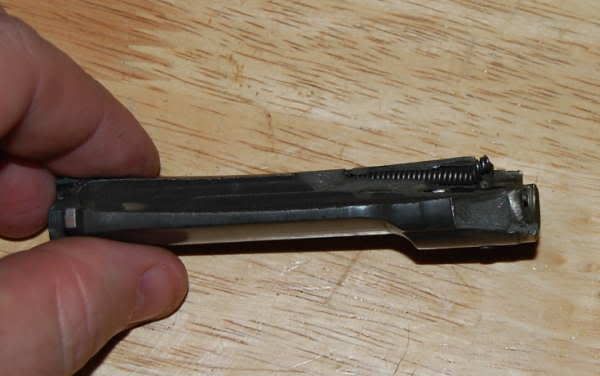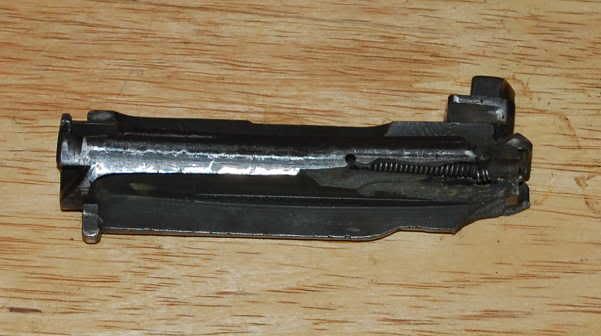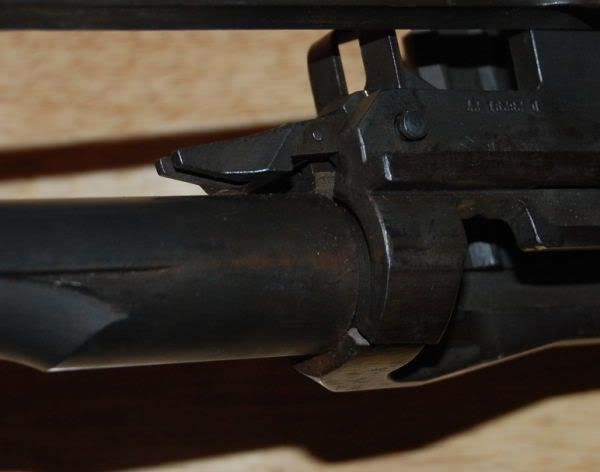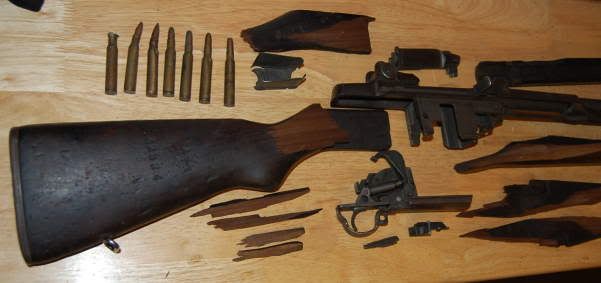Was searching for some info, and a little help. I am a pure novice on rifle ammo, especially older military ammo. I came across a sealed can of 192 cartridges of .30 cal Ball M2 8 Round Clip Bandoleers recently when removing some old military tool chests that had been left vacant in a horse barn. This can is still sealed and in excellent shape, so I am assuming the ammo is still good as well? Is this safe to be sold to someone, or is it's value more for the collector. Not sure of the age, has a lot# of LC39450. any info would be much appreciated! Thank you in advance!
You are using an out of date browser. It may not display this or other websites correctly.
You should upgrade or use an alternative browser.
You should upgrade or use an alternative browser.
Wwii sealed ammo .30-06
- Thread starter PIRATE76
- Start date
Bamashooter
New member
I would guess lake city ammo. 8rd. chargers is M1 Garand clips. I would look at it. If it doesnt look corroded then it should fire. I have some mosin nagant ammo from 1955 that looks brand new and actually shoots very well so you never know.
robmkivseries70
New member
Be aware that this is very likely to be corrosive ammo and clean your rifle accordingly.
Best,
Rob
Best,
Rob
From what I had read on the internet, which is a repeat of what is said in gun magazines, powder has an “indefinite” shelf life. Remember reading statements to the effect that powder lost energy as it got old, making it essentially benign.
Then I ran into an Insensitive Munitions expert. This IM expert explained that powder deteriorates from the day it leaves the factory. Turns out what I "heard" was incorrect or half truths.
Nitrocellulose decomposes through the reduction-oxidation process. Called Redox. The molecular stability of the functional groups on the organic chain determine the life time of the nitrocellulose molecule. All ionic compounds, water is the main offender because it is always in air, react with those bonds and accelerates the deterioration of the powder.
Heat accelerates the deterioration/decomposition of powder and the rate is directly proportional to the Arrhenius equation. If you read in the Insensitive munitions literature, you will see that they use high temperature to accelerate aging of smokeless propellants
The bottom line is that nitrocellulose is a high energy molecule that wants to become a low energy molecule.
The Armed Forces have stockpile surveillance programs but each Service does theirs differently. The Navy samples its powders and propellants. If the powder is outgassing nitric gas (as determined by a paper that changes color (Methly Violet test, or Talliani test)), the stuff is tested to see how much stabilizer is left. If the amount is less than or equal to 20%, the lot is scrapped.
The Army does it different. The Army scraps small arms powders by time. Double based powders and ammunition are scrapped at 20 years, single based 45 years.
The best storage condition for powders is arctic. Cold and dry.
Due to the migration of NG within double based powders, the surface of the grain will become rich in NG even though the total energy content of the propellant has decreased. This will cause changes in the burn rate, and can cause pressures to spike. The surface of nitrocellulose powders also change as the powder deteriorates, and it changes unevenly. This creates conditions for erratic burn rates. Burn rate instability is undesirable and can cause explosive conditions in firearms. It is an extremely rare occurrence, but old ammunition has caused rifle Kabooms.
I believe this is one:
Garand Blowup with old US ammunition.
http://www.socnet.com/showthread.php?p=1344088






Then I ran into an Insensitive Munitions expert. This IM expert explained that powder deteriorates from the day it leaves the factory. Turns out what I "heard" was incorrect or half truths.
Nitrocellulose decomposes through the reduction-oxidation process. Called Redox. The molecular stability of the functional groups on the organic chain determine the life time of the nitrocellulose molecule. All ionic compounds, water is the main offender because it is always in air, react with those bonds and accelerates the deterioration of the powder.
Heat accelerates the deterioration/decomposition of powder and the rate is directly proportional to the Arrhenius equation. If you read in the Insensitive munitions literature, you will see that they use high temperature to accelerate aging of smokeless propellants
The bottom line is that nitrocellulose is a high energy molecule that wants to become a low energy molecule.
The Armed Forces have stockpile surveillance programs but each Service does theirs differently. The Navy samples its powders and propellants. If the powder is outgassing nitric gas (as determined by a paper that changes color (Methly Violet test, or Talliani test)), the stuff is tested to see how much stabilizer is left. If the amount is less than or equal to 20%, the lot is scrapped.
The Army does it different. The Army scraps small arms powders by time. Double based powders and ammunition are scrapped at 20 years, single based 45 years.
The best storage condition for powders is arctic. Cold and dry.
Due to the migration of NG within double based powders, the surface of the grain will become rich in NG even though the total energy content of the propellant has decreased. This will cause changes in the burn rate, and can cause pressures to spike. The surface of nitrocellulose powders also change as the powder deteriorates, and it changes unevenly. This creates conditions for erratic burn rates. Burn rate instability is undesirable and can cause explosive conditions in firearms. It is an extremely rare occurrence, but old ammunition has caused rifle Kabooms.
I believe this is one:
Garand Blowup with old US ammunition.
http://www.socnet.com/showthread.php?p=1344088
There was a thread on another forum titeled “What’s in your ammo can” and many guys had old surpluss ammo so I told this story. Ty (arizonaguide) asked that I come put it here also so here it is boys, draw your own conclutions.
Back in the mid 80s my Dad and a bunch of us went shooting in Arizona. Dad had a couple thousand rounds of WWII surplus .30M1 (30-06) ammo that looked great on the outside cut his M1 in half in his hands. He was kneeling with elbow on knee when the first round of this ammo went BOOM! We were all pelted with sand and M1 shrapnel.
When the dust cleared Dad was rolling around on his back with buttstock in one hand, for stock in the other, barrel and receiver hanging by the sling around his arm trying to yell “mortar” thinking he was back on Okinawa in battle. The blast had removed his ear muffs, hat, glasses, and broke the headlight in my truck 15 feet away but Dad was only shook up and scratched a bit once he got his wits back. It sheared off the bolt lugs, blew open the receiver front ring, pushed all the guts out the bottom of the magazine, and turned the middle of the stock to splinters.
After a couple hours of picking up M1 shrapnel we headed to the loading bench and started pulling bullets. Some of the powder was fine, some was stuck together in clumps, and some had to be dug out with a stick. It didn’t smell and was not dusty like powder usuley is when it’s gone bad. Put it in a pie tin and light it and it seemed a tad fast but not so you would think it could do that, wasent like lighting a pistol powder even. He had 2000 rounds of this stuff and nun of us were in any mood to play with it much after what we watched so it all went onto a very entertaining desert bon fire. I got the M1 splinters when Dad died last year and will post pix here below for your parousal and entertainment.
Anyway, I no longer play with any ammo I am not 100% sure has always been stored properly . . . cheap shooting ain’t worth the risk to me anymore! I still buy surpluss if the price in right but I unload and reload it with powder I am sure of or just use the brass.
She was a good shooting servasable Winchester M1 before this.






Rifleman1776
New member
Too bad you cooked it off. I would have pulled the bullets. Used the powder for garden fertilizer and reloaded.
Thats for sure on burning the stuff. The cases could have been put to use. My guess is there was another issue there too as the general idea is old powder tends to lose its power not have more umpth. When it degrades it tends degrede on the the power level also. But thats only from lab tests and not in the feild stuff.
You are talk/texting to another thread in another forum.Too bad you cooked it off. I would have pulled the bullets. Used the powder for garden fertilizer and reloaded.
The OP is still in possession of his un-opened can.
